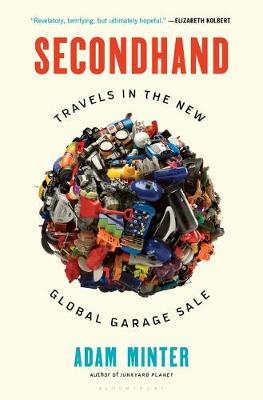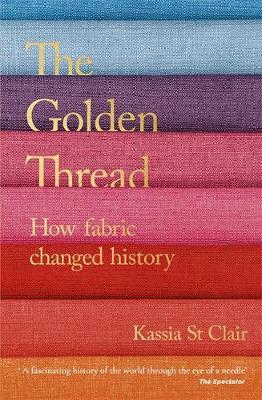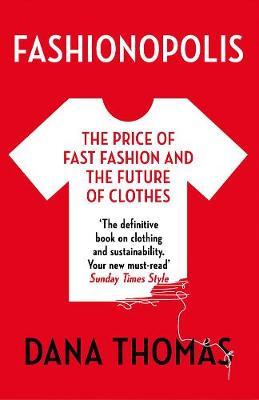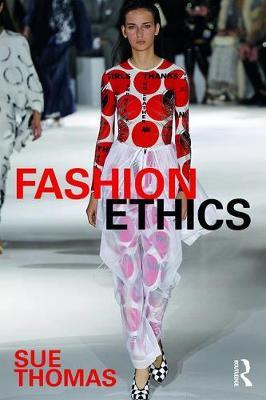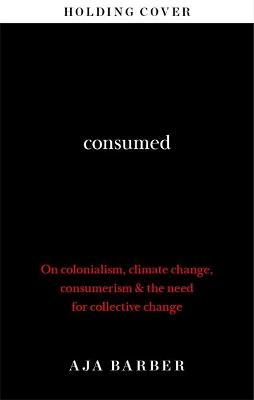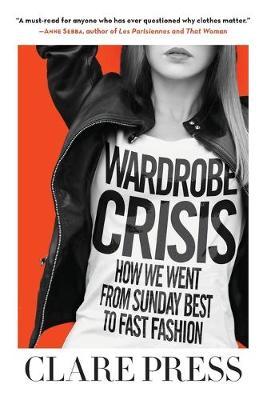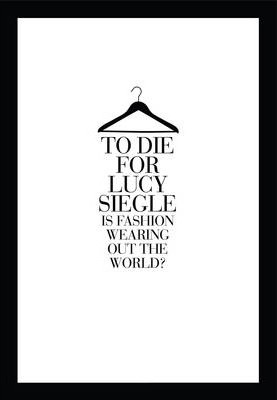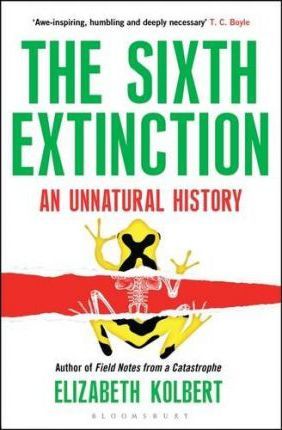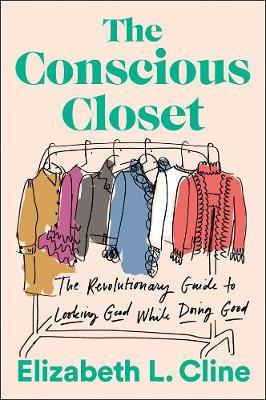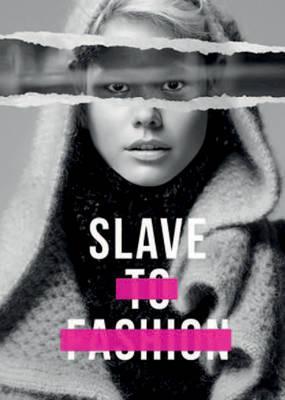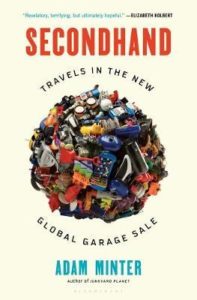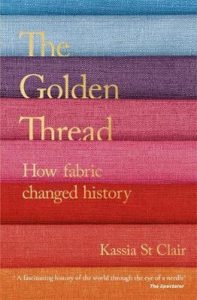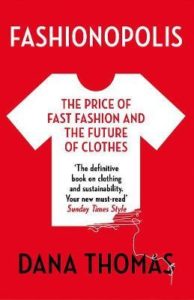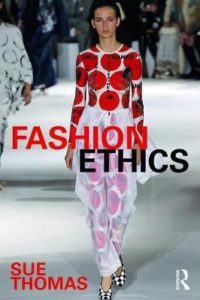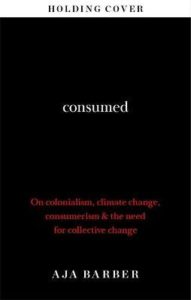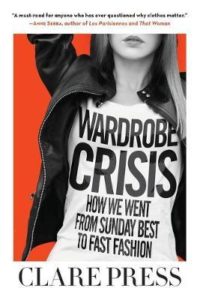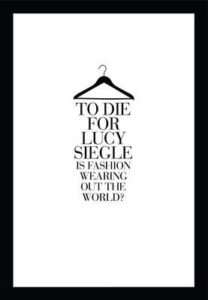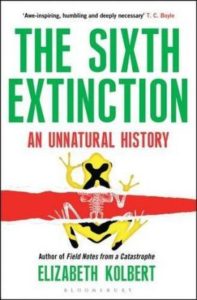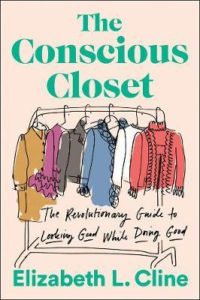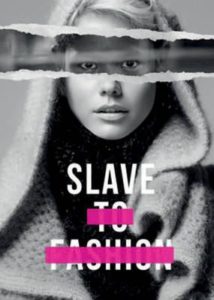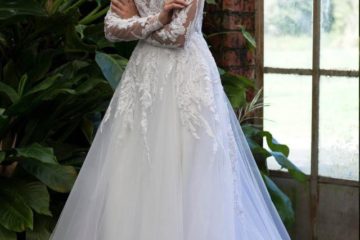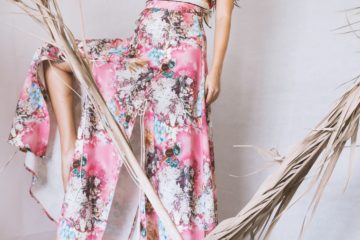Our essential reading list of books for fashion activists (and everyone really), is a comprehensive guide of over 40 books covering everything you need to know; ethical and sustainable fashion, business, design, environment and circularity.
A complete A-Z reading list; from ethics to diversity, sustainable design to greenwashing, this expansive list of reading for fashion activists, environmentalists and enthusiasts is conveniently sorted by topic of interest.
Skip to Categories, or view the Top 10 Books for Fashion Activists
Why Become a Fashion Activist?
There is much to do when it comes to healing ourselves and the environment from the impacts of the fashion industry over the last 50 years. Since the industrial revolution, the way we wear, make and buy fashion has changed dramatically.
The seemingly endless environmental and social problems which have arisen over the last half a century are going to take a lot of work to overcome but there is a growing population of activists ready to do the work both at home, socially, and out in the world.
Some of the most important work is being done right now by boots-on-the-ground activism groups for anti-forced labour and workers rights groups. These not-for-profit organisations and individuals have dedicated their lives to tackling these problems at the source. While you may not find many books published with these first-hand accounts, there are several important reports and websites we recommend visiting to better understand their work.
Ultimately it’s the people who have devoted their lives to protecting garment workers from forced and indentured labour, unequitable wages, unsafe or life-threatening working conditions, abuse and “modern-slavery”, who are making the most difference but are also desperately in need of help. What can the rest of us do?
By becoming a “fashion activist” we can use our individual decision-making power, social influence, and join community awareness and impact programs to amplify the work of campaigns for justice and environmental legislation.
The fashion industry has a lot to answer for; overconsumption, pollution, waste, water use, land use, there simply is no way to make a new product without having a negative impact on the environment. And this before we take account of issues of colonialism in fashion, discrimination, inaccurate and damaging beauty standards, lack of inclusivity, and abuses of human rights.
There certainly is a lot to tackle when it comes to fashion activism and eco-anxiety is a common side effect of taking a deep-dive into multiple issues at once.
This is why it can be a good idea to go ‘offline’ and gain some insight into the fashion industry, its challenges and some solutions by settling down with a well-researched book instead. In doing so we can gain access to some of the ethical and sustainable industries’ most respected and experienced advocates, while avoiding the pitfalls of an internet black hole of information and doomsday informational pieces.
Organised according to area of specialty, the following is a comprehensive reading list for current and future fashion activists, as well as anyone looking to gain further insight into the problems facing the fashion industry today.
Browse; The Essential Reading list: Books for Ethical and Sustainable Fashion Activists
Select one (or more) issues from the following section to start (or continue) your journey, and gain a deeper understanding of issues facing the fashion industry, and how to solve them.
[Disclosure: Ethical Fashion Review is an affiliate partner for Book Depository. Book Depository is a leading international book retailer stocking over 20 million books, whose mission is to provide books at affordable prices. Book Depository provides free worldwide shipping for all orders. Should you choose to purchase using a link in this article, we may receive a commission (at no additional cost to you).]
No time for a long browse? Why not start with one of the Top 10 Books for Fashion Activists as reviewed by our team:
Books by Area of Interest:
Rewearing & Sustainable Fashion
Fashion Design, Studies and Business
FASHION ACTIVISM
The fashion industry has a lot to answer for. In order to make a positive impact, fashion activists need community, and to be armed with the information and tools to make a change. The following books are by some of the best authors and change-makers in the industry to get you there.
Slave to Fashion | Shop this Book
Who it’s for: Activists / Everyone
Author: Safia Minney | Pub. Date: Sept 2017
“Slave to Fashion offers hope of a fairer, more ethical world and gives the reader plenty of tools to navigate a challenging fashion system.” – Livia Firth
Summary/Publisher’s Note:
A Slave to Fashion uses accessible discourse, personal stories, and easy to digest statistics to raise awareness among everyday consumers of fashion. There are over 35 million people trapped in modern slavery fuelled by the global demand for cheap labour, driving the fast fashion industry. Slave to Fashion is a highly readable book in which fair-trade and sustainable fashion expert Safia Minney draws on her extensive experience to draw attention to the human hardship that goes hand-in-hand with producing our clothes. Going further, the book addresses the steps that governments, business leaders, and consumers can take to put an end to this unnecessary suffering. Slave to Fashion celebrates the people fighting for justice and the advocacy groups behind them. The book contains a practical toolkit that anyone can use to demand change from the brands making their clothes. A leader in ethical fashion and business, Safia Minney pioneered the fashion industry’s first fair trade supply chains which has helped to create better industry standards and to improve the lives of marginalized workers in the developing world. Her expertise and experience helps businesses embrace transparency and sustainability in their own backyards.
Naked Fashion: The New Sustainable Fashion Revolution | Shop this Book
Who it’s for: Everyone
Author: Safia Minney | Pub. Date: April 2012
Naked Fashion invites you to join the movement of everyday activists, using their purchasing power and individual talents to make fashion more sustainable.
Summary/Publisher’s Note:
Fashion enthusiasts at any stage of life will find inspiration and insights to make a difference. In Naked Fashion, international designers and creatives discuss what they are doing differently to make fashion more sustainable. Commentary by names like Emma Watson, Summer Rayne Oakes and Vivienne Westwood provide a case-study for action. Author, Safia Minney was first the founder and CEO of fair trade and sustainable fashion label People Tree. She has turned this lifelong passion for environment, trade, and social justice into an award-winning social business with experience that everyone can benefit from. Minney is a leader in the ethical and sustainable fashion movement and was awarded Outstanding Social Entrepreneur by the World Economic Forum and an MBE for her work.
To Die for: Is Fashion Wearing Out the World? | Shop this Book
Who it’s for: Activists / Everyone
Author: Lucy Siegle | Pub. Date: May 2011
One of the founding resources on the corrupt and damaging activities in the fashion industry, To Die For is a must-read for fashion activists or anyone wishing to understand the issues intertwined.
Summary/Publisher’s Note:
The Observer’s ‘Ethical Living’ columnist, Lucy Siegle provides an expose examining the environmentally devastating and inhumane story behind the clothes we wear. Coming at a time when the global financial crisis and contracting of consumer spending is ushering in a new epoch for the fashion industry, To Die For offers a vision of ‘green’ becoming ‘the new black’. Mania for big-name labels and cheap fashion at the forefront, To Die For sets an agenda for the urgent change. Siegle believes that it is achievable for people to be an ‘ethical fashionista’, simply by being aware of how and where (and by whom) clothing is produced. In this impassioned book, the author condemns the global epidemic of unsustainable fashion, and reminds us of our moral accountability to reveal the pitfalls of fast fashion. Siegle discusses the truth behind cut price, mass-produced fashion and the importance of our purchasing decisions, making the case for a new sustainable design era where we are assured of value for money: ethics and morality as a minimum.
Overdressed: The Shockingly High Cost of Cheap Fashion | Shop this Book
Who it’s for: Everyone / Activists
Author: Elizabeth L. Cline | Pub. Date: Aug 2013
“Overdressed does for T-shirts and leggings what Fast Food Nation did for burgers and fries.” —Katha Pollitt
Summary/Publisher’s Note:
Cheap fashion has fundamentally changed the way most of us dress. Stores now offer the latest catwalk looks and newest trends at unprecedentedly low prices meaning consumers have little reason to wear and repair the clothing they already own. Cline sets out to uncover the true nature of the cheap fashion monolith. Where are all these cheap clothes ending up? And more importantly, how is the fashion industry impacting us, changing our society, our environment, and our economic health?
Fashionopolis : The Price of Fast Fashion and the Future of Clothes | Shop this Book
Who it’s for: Everyone
Author: Dana Thomas | Pub. Date: Nov 2019
Fashionopolis is the definitive book on the cost of fast fashion, and a blueprint for developing a more sustainable fashion future.
Summary/Publisher’s Note:
Fashion has blighted our planet. Today, one out of six people on earth work in fashion, churning out 100 billion garments a year. Yet 98 percent of them do not earn a living wage, and 2.1 billion tonnes of clothing is thrown away annually. The clothing industry’s exploitation of people and the environment has reached epic levels. What should we do? Bestselling author and veteran journalist Dana Thomas travelled the globe to bring us the answers. In Fashionopolis, she details the damage wrought by fashion’s behemoths, and celebrates the visionaries – including activists, artisans, designers, and tech entrepreneurs – fighting for change.
The Psychopolitics of Fashion : Conflict and Courage Under the Current State of Fashion | Shop this Book
Who it’s for: Activists / Fashion Designers / Fashion Students
Author: Otto Von Busch | Pub. Date: Feb 2020
“..this book catapults us towards a more mutual, meaningful and alive system of fashion.” Kate Fletcher, Centre for Sustainable Fashion, University of the Arts London, UK
Summary/Publisher’s Note:
If fashion was a state, would it be a democracy? Probably not! Otto von Busch sees fashion as a totalitarian state, with a population all too eager to enact the decrees of its aesthetic superiority. Peers police each other and deploy acts of judgment, peer-regulation, and micro-violence to uphold the aesthetic order of fashion supremacy.
Using four design projects as tools for inquiry, Von Busch explores the seductive desires of envy and violence within fashion drawing on political theories. He proposes that the violent conflicts of fashion happen not only in arid cotton fields or collapsing factories, but in the everyday practice of getting dressed. He suggests that feelings of inclusion and adoration are what make us feel the pleasure of being fashionable-of being seductive, popular, and powerful. Exploring the conflicting psychology associated with fashion, Von Busch assert that while the current state of fashion is bred by fear, The Psychopolitics of Fashion can offer constructive modes of mitigation and resistance. Through disarming the harmful practices of the current state of fashion, Von Busch suggests projects towards a more engaging and meaningful experience of “deep fashion.”
ETHICS & HUMAN RIGHTS
Get to know some of the “boots on the ground” activism campaigns sparking the fashion revolution, and gain a deeper understanding of the most contentious issues.
The Fight for Ethical Fashion : The Origins and Interactions of the Clean Clothes Campaign | Shop this Book
Who it’s for: Activists
Author: Philip Balsiger | Pub. Date: Sep 2014
Summary/Publisher’s Note:
From consumer boycotts and buycotts to social movement campaigns, examples of individual and collective actors forging political struggles on markets are manifold. The clothing market has been a privileged site for such contention, with global clothing brands and retailers being targets of consumer mobilization for the past 20 years. Labels and product lines now attest for the ethical quality of clothes, which has, in turn, given rise to ethical fashion. The Fight for Ethical Fashion unveils the actors and processes that have driven this market transformation through a detailed study of the Europe-wide coordinated campaign on workers’ rights in the global textile industry – the Clean Clothes Campaign. Drawing on insights from qualitative fieldwork using a wide range of empirical sources, Philip Balsiger traces the emergence of this campaign back to the rise of ‘consumer campaigns’ and shows how tactics were adapted to market contexts in order to have retailers adopt and monitor codes of conduct. By comparing the interactions between campaigners and their corporate targets in Switzerland and France (two countries with a very different history of consumer mobilization for political issues), this ground-breaking book also reveals how one campaign can provoke contrasting reactions and forms of market change.
Fashion Ethics | Shop this Book
Who it’s for: Everyone
Author: Sue Thomas | Pub. Date: Sep 2017
Fashion Ethics provides much-needed information for fashion students, industry professionals, and customers.
Summary/Publisher’s Note:
Fashion Ethics provides a comprehensive overview of the ethical issues in the fashion industry, from collection design concept to upcycling and closed loop production. This book answers an urgent need for a comprehensive understanding of the fundamental ethics of the fashion industry. Sue Thomas goes beyond the usual contentious issues of environmental impact and human rights, taking the reader deeper into the endemic issues including sizeism, ageism, animal rights, and the lack of diversity in models and in the media. The book lays out the significant ethical issues within the fashion supply chain by mapping the lifecycle of a garment and exploring key topics such as deep ecology, cultural copyright, speciesism, the role of the customer, and technology in future ethics. It also features current international industry information and industry-relevant case studies from brands, media and mobile technology, and NGOs including Oxfam (UK), Redress (Hong Kong), Nimany (US), Labor Link (US), People Tree (UK), and Peppermint (Australia).
Clothing Poverty : The Hidden World of Fast Fashion and Second-Hand Clothes | Shop this Book
Who it’s for: Everyone
Author: Andrew Brook | Pub. Date: Mar 2015
Summary/Publisher’s Note:
Have you ever stopped and wondered where your jeans came from? Who made them and where? Ever wondered where they end up after you donate them for recycling? Following a pair of jeans, Clothing Poverty takes the reader on a vivid around-the-world tour to reveal how clothes are manufactured and retailed, bringing to light how fast fashion and clothing recycling are interconnected. Andrew Brooks shows how recycled clothes are traded across continents, uncovers how retailers and international charities are embroiled in commodity chains which perpetuate poverty, and exposes the hidden trade networks which transect the globe. Stitching together rich narratives, from Mozambican markets, Nigerian smugglers and Chinese factories to London’s vintage clothing scene, TOMS shoes and Vivienne Westwood’s ethical fashion lines, Brooks uncovers the many hidden sides of fashion.
HISTORY & HOW WE GOT HERE
In order to make a difference it is essential to take stock of the societal evolution, social landscape and how the way we wear and consume fashion has changed.
The following books provide a comprehensive history of fashion for any fashion advocate or enthusiast dedicated to forging a better path.
The Golden Thread : How Fabric Changed History | Shop this Book
Who it’s for: Everyone
Author/Editor: Kassia St Clair | Pub. Date: Jan 2020
Summary/Publisher’s Note:
Running like a bright line through history, The Golden Thread offers an unforgettable adventure through our past, present and future. All textiles begin with a twist. From colourful 30,000-year old threads found on the floor of a Georgian cave to what the linen wrappings of Tutankhamun’s mummy actually meant; from the Silk Roads to the woollen sails that helped the Vikings reach America 700 years before Columbus; from the lace ruffs that infuriated the puritans to the Indian calicoes and chintzes that powered the Industrial Revolution, our continuing reinvention of cloth tells fascinating stories of human ingenuity.
When we talk of lives hanging by a thread, being interwoven, or part of the social fabric, we are part of a tradition that stretches back many thousands of years. Fabric has allowed us to achieve extraordinary things and survive in unlikely places, and this book shows you how — and why.
Fashion History from the 18th to the 20th Century | Shop this Book
Who it’s for: Everyone
Author/Editor: TASCHEN | Pub. Date: March 2020
Summary/Publisher’s Note:
We can use clothing to define ourselves. A person’s attire is like a code to culture, class, personality, even faith. Founded in 1978, the Kyoto Costume Institute recognizes the importance of understanding clothes from sociological, historical, and artistic perspectives. With one of the world’s most extensive clothing collections, the KCI has amassed a wide range of historical garments, underwear, shoes, and fashion accessories dating from the 18th century to the present day. Showcasing the Institute’s vast collection, Fashion History is a fascinating excursion through clothing trends from the 18th to the 20th century. Featuring impeccable photography of clothing expertly displayed and arranged on custom-made mannequins, it is a testimony to attire as “an essential manifestation of our very being” and to the Institute’s passion for fashion as a complex and intricate art form. The authors include: Akiko Fukai (Director and Curator Emeritus of the Kyoto Costume Institute), Tamami Suoh (Curator of The Kyoto Costume Institute), Miki Iwagami (Lecturer of fashion history at Bunka Gakuen University, Tokyo), Reiko Koga (former professor of fashion history at Bunka Gakuen University, Tokyo), and Rie Nii (Curator of The Kyoto Costume Institute).
The Fabric of Civilization: How Textiles Made the World | Shop this Book
Who it’s for: Everyone
Author: Virginia Postrel | Pub. Date: Nov 2020
The story of humanity is the story of textiles — as old as civilization itself. Since the first thread was spun, the need for textiles has driven technology, business, politics, and culture.
Summary/Publisher’s Note:
From Paleolithic flax to 3D knitting, explore the global history of textiles and the world they weave together in this enthralling and educational guide. In The Fabric of Civilization, Virginia Postrel synthesizes groundbreaking research from archaeology, economics, and science to reveal a surprising history. From Minoans exporting wool colored with precious purple dye to Egypt, to Romans arrayed in costly Chinese silk, the cloth trade paved the crossroads of the ancient world. Textiles funded the Renaissance and the Mughal Empire; they gave us banks and bookkeeping, Michelangelo’s David and the Taj Mahal. The cloth business spread the alphabet and arithmetic, propelled chemical research, and taught people to think in binary code. Assiduously researched and deftly narrated, The Fabric of Civilization tells the story of the world’s most influential commodity.
Cheap: The High Cost of Discount Culture | Shop this Book
Who it’s for: Everyone / Activists
Author: Ellen Ruppel Shell | Pub. Date: June 2010
Summary/Publisher’s Note:
A myth-shattering investigation of the true cost of America’s passion for finding a better bargain. From the shuttered factories of the Rust Belt to the strip malls of the Sun Belt-and almost everywhere in between-America has been transformed by its relentless fixation on low price. This pervasive yet little- examined obsession with bargains is arguably the most powerful and devastating market force of our time, having fueled an excess of consumerism that blights our landscapes, escalates personal debt, lowers our standard of living, and even skews of our concept of time. Spotlighting the peculiar forces that drove Americans away from quality, durability, and craftsmanship and towards quantity, quantity, and more quantity, Ellen Ruppel Shell traces the rise of the bargain through our current big-box profusion to expose the astronomically high cost of cheap.
Wardrobe Crisis: How We Went from Sunday Best to Fast Fashion | Shop this Book
Who it’s for: Everyone
Author: Clare Press | Version Pub. Date: Feb 2018
Summary/Publisher’s Note:
While once our clothing was made by people we knew; a seamstress, tailor, relative or perhaps you made them yourself. Today it is more difficult to determine the origins, let alone the makers of the clothing we own. Local makers have been replaced by a global fashion industry which generates $1.5 trillion a year. In her book, author and fashion journalist Clare Press provides insights to the history and ethics inside our closets. Using unique industry insights, Press examines the entire fashion ecosystem, from sweatshops to haute couture, unearthing the roots of today’s buy-and-discard culture. Tracing the inception of iconic fashion houses like Chanel, Dior, and Hermès; Press presents the rise and fall of the department store; and follows the journey that took us from Marie Antoinette to Carrie Bradshaw. Wardrobe Crisis is a witty and persuasive argument for a fashion revolution that will empower you to feel good about your wardrobe once more.
Note: Film/TV rights to the Wardrobe Crisis book have been sold to Essential Media, who are expected to produce a series or a documentary based on this publication.
Sustainable Fashion: Past, Present and Future | Shop this Book
Who it’s for: Everyone
Author: Jennifer Farley Gordon & Colleen Hill | Pub. Date: Jan 2015
Summary/Publisher’s Note:
Sustainable Fashion: Past, Present and Future provides a unique and accessible look at fashion ethics and sustainability issues of the past, present and future. This book discusses today’s eco-fashion movement in its multifaceted historical context, investigating the relationship between fashion and the environment as far back as the early nineteenth century.
Employing an expanded definition of sustainability that also considers ethical issues, Farley Gordon and Hill explore each stage of the fashion production cycle, from the cultivation of raw fibers to the shipment of the finished garment. Structured thematically, each of the six chapters is dedicated to the discussion of one major issue, from recycling and repurposing to labor practices and the treatment of animals. Including interviews with eco-fashion designers, Sustainable Fashion will appeal to students and scholars of fashion, as well as students of design, history and cultural studies.
Eco-chic: The Fashion Paradox | Shop this Book
Who it’s for: Everyone
Author: Sandy Black | Pub. Date: March 2008
Summary/Publisher’s Note:
In a comprehensive survey, academic Sandy Black examines the way the fashion industry adapts to accommodate the environmental concerns of the twenty-first century. She exposes the naked truth behind the clothes we wear, exploring alternate practices and assessing their feasibility. Using case studies of designers from the catwalks and the high street, including Katharine Hamnett, Marks and Spencer and Linda Loudermilk, the book illustrates how these processes are finding their way into the industry, and shows how ethical fashion has moved on from its traditional connotations of hemp shirts and rope sandals.
Fashion and environmental awareness are two concerns that in recent times have not comfortably co-habitated. High street fashion, led by global chains, has become ever more affordable and disposable, while material sourcing, manufacture and distribution of fashion have become the dirty secrets of an industry selling beauty and glamour. Lavishly illustrated Eco-Chic provides a commitment to the environment and to responsible design that appeals equally to the fashion conscious and environmentally aware.
The Story of Stuff: The Impact of Overconsumption on the Planet, Our Communities, and Our Health-And How We Can Make It Better | Shop this Book
Who it’s for: Activists / Everyone
Author: Annie Leonard | Pub. Date: Feb 2011
Summary/Publisher’s Note:
The Story of Stuff explores the ongoing threat of overconsumption on the environment, economy, and our health. Annie Leonard offers a constructive critique of “stuff” we use daily, and steps for an altered way of living in more accordance with the planet.
Uncovering and communicating a critically important idea—that there is an intentional system behind our patterns of consumption and disposal—Leonard transforms how we think about our lives and our relationship to the planet. From sneaking into factories and dumps around the world to visiting textile workers in Haiti and children mining coltan for cell phones in the Congo, Leonard highlights each step of the materials economy and its actual effect on the earth and the people who live near sites like these.
With curiosity, compassion, and humor, the author shares actionable steps for activism at the individual and political level that will bring about sustainability, community health, and economic justice. Embraced by teachers, parents, churches, community centers, activists, and everyday readers, The Story of Stuff is a long-lived classic.
Sixth Extinction: An Unnatural History | Shop this Book
Who it’s for: Activists / Environmentalists / Everyone
Author: Elizabeth Kolbert | Pub. Date: 2014
WINNER OF THE PULITZER PRIZE | A NEW YORK TIMES BESTSELLER
Summary/Publisher’s Note:
A book about the future of the world, blending intellectual and natural history and field reporting into a powerful account of the mass extinction unfolding before our eyes. Over the last half-billion years, there have been Five mass extinctions, when the diversity of life on earth suddenly and dramatically contracted. Scientists around the world are currently monitoring the sixth extinction, predicted to be the most devastating extinction event since the asteroid impact that wiped out the dinosaurs. This time around, the cataclysm is us.
In prose that is at once frank, entertaining, and deeply informed, New Yorker writer Elizabeth Kolbert tells us why and how human beings have altered life on the planet in a way no species has before. Interweaving research in half a dozen disciplines, descriptions of the fascinating species that have already been lost, and the history of extinction as a concept, Kolbert provides a moving and comprehensive account of the disappearances occurring before our very eyes. She shows that the sixth extinction is likely to be mankind’s most lasting legacy, compelling us to rethink the fundamental question of what it means to be human.
The End of Fashion: How Marketing Changed the Clothing Business Forever | Shop this Book
Who it’s for: Activists / Fashion Designers / Fashion Students
Author: Terri Agins | Pub. Date: Oct 2000
Summary/Publisher’s Note:
A solid, hard-hitting, and uncompromising journalistic look at the fashion industry. The time when fashion was defined by French designers whose clothes could be afforded only by the elite has ended. Now designers take their cues from mainstream consumers and creativity is channeled more into mass-marketing clothes than into designing them. Indeed, one need look no further than the Gap to see proof of this. In The End of Fashion, Wall Street Journal, reporter Teri Agins astutely explores this seminal change, laying bare all aspects of the fashion industry from manufacturing, retailing, and licensing to image making and financing. Here as well are fascinating insider vignettes that show Donna Karan fighting with financiers, the rivalry between Ralph Lauren and Tommy Hilfiger, and the commitment to haute couture that sent Isaac Mizrahi’s business spiraling.
GREENWASHING
A blight on the sustainable and ethical fashion industry, is the use of misleading and unsubstantiated eco-claims in a product’s marketing, known as greenwashing. Green-washing convolutes the message of brands and clothing that are in fact made using fair labour practices and reduced impact on the environment. Greenwashing statements are often vague, broad claims about eco/conscious ideals or the products themselves, designed to intentionally mislead customers about the impact of their purchase. Greenwashing is commonly used by largely-profitable businesses looking to capture the “green dollar” or appear more eco-friendly to consumers. Here’s how to wise up to the transparency-avoiding marketing tactics of these businesses. It is high time that corporations stop trying to mislead customers while maintaining their unsustainable business models, and instead focus on people and the environment as a priority.
The Greenwash Effect: Corporate Deception, Celebrity Environmentalists, and What Big Business Isn’t Telling You about Their Green Products and Brands | Shop this Book
Who it’s for: Everyone
Author: Guy Pearse | Pub. Date: Aug 2014
Summary/Publisher’s Note:
Going green is the new black for big business. But how real is the climate-friendly revolution that’s being advertised? Toyota would like us to think that Mother Nature drives a Prius, Ford wants us to “Join the Green Revolution,” and McDonald’s has painted its golden arches green. Facebook has even “friended” Greenpeace. All across the globe big corporations are spending big bucks trying to convince us that their policies, actions, and products are earth friendly. But are big brands and the celebrities endorsing them really as green as they claim?
In The Greenwash Effect, Guy Pearse looks behind the corporate facade in the tradition of Fast Food Nation and No Logo and what he finds will startle you. Nothing is sacred and no one is safe from scrutiny: not the World Wildlife Fund or Earth Hour, not Apple or Google, not Oprah or Leonardo DiCaprio. The Greenwash Effect is an entertaining and practical book that helps consumers to pick the truly green businesses from the greenwashers and to demand a higher environmental standard from all.
REWEARING, REPAIRING & BUYING FASHION SUSTAINABLY
The way we make, buy and discard clothing has changed dramatically over the last century. It is essential for us to completely overhaul our current fashion consumption and remodel the way we, as consumers and activists, view the impact of our clothing.
The number one sustainable option to reduce your fashion impact is to go naked. The second is by maximising what we already have, taking care of and really getting to know the garments we own. The following books compile a detailed lesson in garment care and sustainable fashion.
Loved Clothes Last: How the Joy of Rewearing and Repairing Your Clothes Can Be a Revolutionary Act | Shop this Book
Who it’s for: Everyone
Author: Orsola de Castro | Pub. Date: Feb 2021
Summary/Publisher’s Note:
The ultimate guide from Fashion Revolution activist, Orsola de Castro, on how to love, mend and repair your clothes in the fight against fast fashion. Running out of space for the clothes you can’t stop buying? Curious about how you can make a difference to the environmental challenges our planet faces? Join Orsola’s care revolution and learn to make the clothes you love last longer. This book will equip you with a myriad of ways to mend, rewear and breathe new life into your wardrobe to achieve a more sustainable lifestyle. By teaching you to scrutinise your shopping habits and make sustainable purchases, she will inspire you to buy better, care more and reduce your carbon footprint by simply making your loved clothes last longer. Following Orsola’s practical tips to lavish care and attention on the clothes you already own will not only have a positive environmental impact, but will be personally rewarding too: hand wash, steam and spot clean your clothes, air dry instead of tumble drying, or revive your clothes by sewing or crocheting. Fast fashion leaves behind a trail of human and environmental exploitation. Our wardrobes don’t have to be the finish line; they can be a starting point. We can all care, repair and rewear. Do you accept the challenge?
About the Author: After founding Fashion Revolution in 2013, Orsola de Castro pioneered a global campaign in response to the Rana Plaza factory collapse and became an internationally recognised opinion leader in sustainable fashion.
The Sustainable Fashion Handbook | Shop this Book
Who it’s for: Everyone
Author: Sandy Black | Pub. Date: Apr 2013
Summary/Publisher’s Note:
This book aims to take its place as a reference material for all aspects of eco-fashion. The Sustainable Fashion Handbook is a comprehensive source of features and facts, inspiring images and ideas. Divided into five thematic chapters covering every aspect of contemporary fashion from fashion cultures (from high street to blogosphere to couture), to the eco-footprint of the current resource-hungry and wasteful system, to the fashion business, employer of up to 40 million people worldwide. Each chapter presents an array of illustrated articles including essays by leading writers and thinkers, statements from designers such as Stella McCartney, EDUN founder Ali Hewson, Vivienne Westwood, Yohji Yamamoto, Issey Miyake, interviews with such designers as Katharine Hamnett, Hussein Chalayan, Dries van Noten, Lorrie Vogel (Nike) as well as presenting future scenarios which set out how things could be if we do – or don’t – succeed in enacting radical change. Finally a resources section provides comprehensive listings of leading organizations involved in campaigning, advising, certifying, footprinting and promoting sustainability worldwide.
ReFashioned: Cutting-Edge Clothing from Upcycled Materials Hardcover | Shop this Book
Who it’s for: Fashion Designers / Fashion Students / Everyone
Author: Sass Brown | Pub. Date: Oct 2013
Summary/Publisher’s Note:
The area of recycling and upcycling is a rich and growing source of innovative design in the fashion and accessories industries. In a fast-fashion world of throw-away clothing, it is the ultimate expression of the slow-fashion movement, with each piece individually conceived and crafted from scratch, using different materials each time. ReFashioned features 46 international designers who work with recycled materials and discarded garments, reinvigorating them with new life and value. The result is beautiful and desirable clothing and accessories that also make an important statement to the fashion world about its wasteful and exploitative practices.
The Conscious Closet: The Revolutionary Guide to Looking Good While Doing Good | Shop this Book
Who it’s for: Everyone / Activists / Environmentalists / Fashion Designers / Fashion Students / Everyone
Author: Elizabeth L. Cline | Pub. Date: Aug 2019
Summary/Publisher’s Note:
From journalist, fashionista, and clothing resale expert Elizabeth L. Cline, comes the definitive guide to building an ethical, sustainable wardrobe you’ll love. Clothing is one of the most personal expressions of who we are. In her landmark investigation Overdressed: The Shockingly High Cost of Cheap Fashion, Elizabeth L. Cline first revealed fast fashion’s hidden toll on the environment, garment workers, and even our own satisfaction with our clothes. The Conscious Closet shows exactly what we can do about it. Whether your goal is to build an effortless capsule wardrobe, keep up with trends without harming the environment, buy better quality, seek out ethical brands, or all of the above, The Conscious Closet is packed with the vital tools you need. Elizabeth delves into fresh research on fashion’s impacts and shows how we can leverage our everyday fashion choices to change the world through style. Inspired by her own revelatory journey getting off the fast-fashion treadmill, Elizabeth shares exactly how to build a more ethical wardrobe, starting with a mindful closet clean-out and donating, swapping, or selling the clothes you don’t love to make way for the closet of your dreams. The Conscious Closet is not just a style guide. It is a call to action to transform one of the most polluting industries on earth—fashion—into a force for good. Readers will learn where our clothes are made and how they’re made, before connecting to a global and impassioned community of stylish fashion revolutionaries. In The Conscious Closet, Elizabeth shows us how we can start to truly love and understand our clothes again—without sacrificing the environment, our morals, or our style in the process.
Wear No Evil: How to Change the World with Your Wardrobe | Shop this Book
Who it’s for: Everyone
Author: Greta Eagan | Pub. Date: March 2014
Summary/Publisher’s Note:
It’s time for a conversation about fashion – how it is produced, consumed, and discarded – to fit with the world we live in today. Have you ever wondered, “How can I do good while looking good?” Wear No Evil has the answer, and is an easy to digest handbook for navigating both fashion and ethics. A style guide with sustainability built in, Wear No Evil explains that as a consumer, you regain your power with every purchase that supports the causes you already advocate for in life, while upholding your sense of self through the stylish pieces you use in your wardrobe. Featuring the Integrity Index (a simplified way of identifying the ethics behind any piece of fashion) and an easy to use rating system, you’ll learn to shop anywhere while building your personal style and supporting your values. Fashion is the last frontier in the shift towards conscious living. Wear No Evil provides a roadmap founded in research and experience, coupled with real life style and everyday inspiration. The book cleanly presents important aspects of changing consumption habits to improve the sustainability and ethical repercussions of our wardrobes, in three parts. Part 1 presents the facts driving the fashion industry and why our shopping habits need a reboot. Part 2 provides a closet-cleansing exercise and instructions for eco-friendly fashion purchasing. Part 3 showcases eco-fashion makeovers and a directory of natural beauty recommendations to further reduce personal environmental impact.
Eco Fashion | Shop this Book
Who it’s for: Everyone
Author: Sass Brown | Pub. Date: Oct 2010
Summary/Publisher’s Note:
One of the strongest trends in fashion is the expression of ecological, social and community consciousness through for-profit fashion design corporations. There is now a wide range of companies offering well designed merchandise, from one-off art, recycled and redesigned clothing, organic and sustainable textiles and garment production, to a range of community and indigenous support cooperatives bridging the gap between traditional craft and high fashion. Eco Fashion shows the range of international companies who are making a difference with their desirable and well-designed apparel and accessories with a conscience. This book explains the stories behind the companies and features stunning illustrations, to reveal how and where they make a difference.
Secondhand: Travels in the New Global Garage Sale | Shop this Book
Who it’s for: Everyone
Author: Adam Minter | Pub. Date: Nov 2019
“Revelatory, terrifying, but, ultimately, hopeful.” ―Elizabeth Kolbert, author of The Sixth Extinction
Summary/Publisher’s Note:
Secondhand: Travels in the New Global Garage Sale is a journey into the surprising afterlives of our former possessions. Downsizing. Decluttering. Discarding. Sooner or later, all of us are faced with things we no longer need or want. But when we drop our old clothes and other items off at a local donation center, where do they go? Sometimes across the country―or even halfway across the world―to people and places who find value in what we leave behind. Author and journalist Adam Minter takes us on an unexpected adventure into the often-hidden, multibillion-dollar industry of reuse: thrift stores in the American Southwest to vintage shops in Tokyo, flea markets in Southeast Asia to used-goods enterprises in Ghana, and more. Along the way, Minter meets the fascinating people who handle―and profit from―our rising tide of discarded stuff, and asks a pressing question: In a world that craves shiny and new, is there room for it all? Secondhand offers hopeful answers and hard truths. A history of the stuff we’ve used and a contemplation of why we keep buying more, it also reveals the marketing practices, design failures, and racial prejudices that push used items into landfills instead of new homes. Secondhand shows us that it doesn’t have to be this way, and what really needs to change to build a sustainable future free of excess stuff.
Modern Mending | Shop this Book
Who it’s for: Everyone
Author: Erin Lewis-Fitzgerald | Pub. Date: Feb 2020
Summary/Publisher’s Note:
Bring new life to your old clothes and fabrics with this fun, easy-to-follow guide to modern mending. In Australia, we send millions of tonnes of clothing to landfill each year. In fact, our clothing consumption is one of the highest in the world. But the good news is that mending is trending and it’s never been easier to repair and reinvent your favourite clothes.
Inspired by the slow fashion movement taking over the world, Erin Lewis-Fitzgerald has created a comprehensive guide to mending your own clothes that combines creativity and sustainability. In Modern Mending she demystifies mending and shares step-by-step instructions for a range of techniques, including stitching, darning, patching, needle felting and machine darning. So next time you tear your favourite jeans or find a hole in your jumper think twice before throwing them away. With Modern Mending you’ll gain the skills and confidence needed to rebel against fast fashion.
Visible Mending : Repair, Renew, Reuse The Clothes You Love | Shop this Book
Who it’s for: Everyone
Author: Arounna Khounnoraj | Pub. Date: Nov 2020
Summary/Publisher’s Note:
In the movement against throw-away culture and fast fashion, learn how to pick up a needle and rediscover the forgotten techniques and the joy of mending. In Visible Mending, Arounna Khounnraj explores why we should mend, and how to mend a variety of different fabrics. Discover how to repair forgotten pieces and give worn-out clothes a new life. Illustrated step-by-step instructions will demystify mending techniques that can be easily applied to old items to give them a fresh, modern look. Each of the projects examine how to repair, reuse and renew the clothes you love, from patching jeans, embroidering over tears to dyeing to hide stains and using the Japanese art of Sashiko. Visible Mending is for those who want to learn how to make the most of their wardrobes, be less wasteful, more sustainable and add a personal touch to their garments.
FASHION STUDIES, DESIGN AND BUSINESS
Who is in a better position to shape the future of the fashion industry than fashion students and the fashion designers themselves? The following books are aimed at helping people in the industry to understand the intricacies of the many issues facing the fashion industry, and tackle them proactively.
Ethics in the Fashion Industry | Shop this Book
Who it’s for: Fashion Designers / Fashion Students
Author: V. Ann Paulins & Julie L. Hillery | Pub. Date: Apr 2020
Summary/Publisher’s Note:
Learn how to make ethical decisions on a daily basis. This second edition of Ethics in the Fashion Industry continues to document the relationships between functions in the fashion industry and the people who make these functions happen. Covering topics such as corporate social responsibility, social media, social compliance audits, diversity, and human rights, this book empowers students who will soon become fashion professionals to make good decisions. Whether debating issues like factory conditions, fair wages, fast fashions, or designer knock-offs, shoplifting, and controversial advertising, Ethics in the Fashion Industry gives you the tools to do the right thing. Three features; Ethics in the Industry highlights relevant industry practices relating to ethics; Ethics in the News analyzes recent reporting on ethics; and Ethics in Practice profiles present industry professionals’ and fashion scholars’ work in the context of the chapter’s topic. Case Studies: Each chapter ends with two Case Studies that facilitate exploration of current and relevant industry activities into the knowledge-building process, allowing students to think critically on scenarios that may present themselves in the course of their careers. New Insights: The responsibility that millennials, Gen Xers, and Gen Nexters have in positioning not only the fashion industry, but the planet itself, for a healthy future cannot go unobserved. This edition includes new insights about generational behaviors and perspectives in making ethical decisions, in addition to the role that consumers play in shaping fashion industry decisions.
Sustainable Fashion: What’s Next? A Conversation about Issues, Practices and Possibilities | Shop this Book
Who it’s for: Activists / Environmentalists / Fashion Designers / Fashion Students
Author: Janet Hethorn & Connie Ulasewicz | Pub. Date: Dec 2015
Summary/Publisher’s Note:
As issues surrounding sustainability in the fashion industry continue to evolve, the conversation in this collection of essays from leading fashion academics and practitioners has been updated with current concepts and industry practices. Sustainable Fashion: What’s Next? A Conversation about Issues, Practices and Possibilities, examines the challenges that designers, product developers, and consumers confront as they create, wear, and recycle clothing and fashion. Organized into three sections and printed on FSC-certified paper, each section focuses on an in-depth exploration of sustainable opportunities that are identified as people, process and the environment.
Zero Waste Fashion Design | Shop this Book
Who it’s for: Fashion Designers / Fashion Students
Author: Timo Rissanen & Holly McQuillan | Pub. Date: Sept 2018
Summary/Publisher’s Note:
Zero Waste Fashion Design combines research and practice to introduce a crucial sustainable fashion design approach. Written by two industry leading pioneers, Timo Rissanen and Holly McQuillan, the book offers flexible strategies and easy-to-master zero waste techniques to help you develop your own cutting edge fashion designs.
Sample flat patterns and more than 20 exercises will reinforce your understanding of the zero waste fashion design process. Beautifully illustrated interviews with high-profile, innovative designers, including Winifred Aldrich, Rickard Lindqvist and Yeohlee Teng, show the stunning garments produced by zero waste fashion design. Featured topics include; The criteria for zero waste fashion design, Manufacturing zero waste garments, Adapting existing designs for zero waste, and Zero waste designing with digital technologies.
Fashion and Sustainability: Design for Change | Shop this Book
Who it’s for: Activists Fashion Designers / Fashion Students
Author: Kate Fletcher & Lynda Grose | Pub. Date: Mar 2012
Summary/Publisher’s Note:
This book examines how sustainability has the potential to transform both the fashion system and the innovators who work within it. The book is organized in three parts. The first part is concerned with transforming fashion products across the garment’s lifecycle and includes innovation in materials, manufacture, distribution, use, and re-use. The second part looks at ideas that are transforming the fashion system at root into something more sustainable, including new business models that reduce material output. The third section is concerned with transforming the role of fashion designers and looks to examples where the designer changes from a stylist or shaper of things into a communicator, activist or facilitator.
Fibershed: Growing a Movement of Farmers, Fashion Activists, and Makers for a New Textile Economy | Shop this Book
Who it’s for: Activists / Environmentalists / Fashion Designers
Author: Rebecca Burgess & Courtney White | Pub. Date: Nov 2019
A new “farm-to-closet” vision for the clothes we wear–by a leader in the movement for local textile economies.
Summary/Publisher’s Note:
In Fibershed readers will learn how natural plant dyes and fibers such as wool, cotton, hemp, and flax can be grown and processed as part of a scalable, restorative agricultural system. Fibershed is a resource for fiber farmers, ranchers, contract grazers, weavers, knitters, slow-fashion entrepreneurs, soil activists, and conscious consumers who want to join or create their own fibershed and topple outdated and toxic systems of exploitation.
There is a disconnect between what we wear and our knowledge of its impact on land, air, water, labor, and human health. Even those who value access to safe, local, nutritious food have largely overlooked the production of fiber, dyes, and the chemistry that forms the backbone of modern textile production. While humans are 100 percent reliant on their second skin, it’s common to think little about the biological and human cultural context from which our clothing derives. Almost a decade ago, weaver and natural dyer Rebecca Burgess developed a project focused on wearing clothing made from fiber grown, woven, and sewn within her bioregion. As she began to network with ranchers, farmers, and artisans, she discovered that even in her home community there was ample raw material being grown to support a new regional textile economy with deep roots in climate change prevention and soil restoration.
Burgess saw that we could create viable supply chains of clothing that could become the new standard in a world looking to solve the climate crisis.
Handbook of Sustainable Luxury Textiles and Fashion | Shop Volume 1 | Shop Volume 2
Who it’s for: Fashion Designers / Fashion Students
By: Miguel Angel Gardetti (Author) & Subramanian Senthilkannan Muthu (Editor) | Pub. Date: Oct 2016
Summary/Publisher’s Note:
Volume 1: The first volume of this handbook explores different aspects of sustainable luxury textiles and fashion, broadly based on the following topics: Sustainability and business management, Value chain management, Use of materials and Sustainable production processes.
Volume 2: The second volume of handbook explores different dimensions of the sustainable luxury textiles and fashion, broadly based on the following topics: Sustainable luxury, Luxury and consumption, Luxury, innovation and design potential, Luxury and entrepreneurship, and Sustainable Luxury Management.
Models for Sustainable Framework in Luxury Fashion: Luxury and Models | Shop this Book
Who it’s for: Fashion Designers / Fashion Students
Edited by Subramanian Senthilkannan Muthu | Pub. Date: Dec 2018
Summary/Publisher’s Note:
This book highlights the models developed to create a sustainable framework suitable for luxury in the textile sector and the innovative attempts in the luxury fashion and fabrics industry. The three chapters in this book discuss these issues by means of case studies and the future of such models.
THE CIRCULAR FASHION/BUSINESS MODEL
The end of useable lifecycle for a product plays a major role in its environmental impact and sustainability. Considering the proper application of resources, low-waste design, minimising harmful chemicals and planning for end-of-life of a garment in the design phase, is the best way to reduce the impact of the item overall. Here is the latest information clarifying the once complex issue of circular business models for fashion.
The Future of Packaging: From Linear to Circular | Shop this Book
Who it’s for: Environmentalists / Fashion Designers / Everyone
Author: Tom Szaky | Pub. Date: Feb 2019
Summary/Publisher’s Note:
Outstanding Book of the Year gold medalist and “Most Likely to Save the Planet” from the Independent Book Publisher Awards. Authored by recycling pioneer, eco-capitalist, and founder and CEO of TerraCycle Tom Szaky sets out to do the impossible – eliminate all waste. This book paints a future of a circular economy that relies on responsible reuse and recycling to propel the world towards eradicating overconsumption and waste. The collection showcases how manufacturers can move from a one-way take-make-waste economy that is burying the world in waste to a circular, make-use-recycle economy. From the distinct perspectives of government leaders, consumer packaged goods companies, waste management firms, and more, the book explores current issues of production and consumption, practical steps for improving packaging and reducing waste today, and big ideas and concepts that can be carried forward. Intended to help every business from a small start-up to a large established consumer product company, this book serves as a source of knowledge and inspiration. The message from these pioneers is not to scale back but to innovate upward. They offer nothing less than a guide to designing ourselves out of waste and into abundance.
Circular Fashion: A Supply Chain for Sustainability in the Textile and Apparel Industry | Shop this Book
Who it’s for: Environmentalists / Fashion Designers / Fashion Students
Author: Peggy Blum | Pub. Date: Apr 2021
Summary/Publisher’s Note:
Creating sustainable fashion has never been more important. Circular Fashion provides an accessible, practical, and holistic approach to this key topic for anyone studying fashion. This introductory text to sustainability in fashion includes best practice case studies and profiles of key companies such as Patagonia, Veja, Christopher Raeburn, and Stella McCartney. It begins with an overview of the fashion business, tackling the issues of the linear production model of make, use, dispose, before introducing the idea of the circular supply chain. Circular Fashion is the must-have book for fashion students, creatives and anyone passionate about sustainability and fashion.
Cradle to Cradle: Remaking the Way We Make Things | Shop this Book
Who it’s for: Environmentalists
Author: Michael Braungart | Pub. Date: April 2010
Summary/Publisher’s Note:
A manifesto for a radically different philosophy and practice of manufacture and environmentalism. “Reduce, reuse, recycle” urges environmentalists; in other words, do more with less in order to minimize damage. But as this provocative, visionary book argues, this approach perpetuates a one-way, “cradle to grave” manufacturing model that dates to the Industrial Revolution and casts off as much as 90 percent of the materials it uses as waste, much of it toxic. Why not challenge the notion that human industry must inevitably damage the natural world? In fact, why not take nature itself as our model? A tree produces thousands of blossoms in order to create another tree, yet we do not consider its abundance wasteful but safe, beautiful, and highly effective; hence, “waste equals food” is the first principle the book sets forth. Products might be designed so that, after their useful life, they provide nourishment for something new-either as “biological nutrients” that safely re-enter the environment or as “technical nutrients” that circulate within closed-loop industrial cycles, without being “downcycled” into low-grade uses (as most “recyclables” now are).
Elaborating their principles from experience (re)designing everything from carpeting to corporate campuses, William McDonough and Michael Braungart make an exciting and viable case for change.
A New Textiles Economy: Redesigning Fashion’s Future | Read This [Free]
Who it’s for: Environmentalists / Fashion Designers / Fashion Students / Everyone
Author: Ellen Macarthur Foundation | Pub. Date: Nov 2017
Summary/Publisher’s Note:
Fashion is a vibrant industry that employs hundreds of millions, generates significant revenues, and touches almost everyone, everywhere. Since the 20th century, clothing has increasingly been considered as disposable, and the industry has become highly globalised, with garments often designed in one country, manufactured in another, and sold worldwide at an ever-increasing pace. This trend has been further accentuated over the past 15 years by rising demand from a growing middle class across the globe with higher disposable income, and the emergence of the ‘fast fashion’ phenomenon, leading to a doubling in production over the same period. The time has come to transition to a textile system that delivers better economic, societal, and environmental outcomes. The report A new textiles economy: Redesigning fashion’s future outlines a vision and sets out ambitions and actions – based on the principles of a circular economy – to design out negative impacts and capture a USD 500 billion economic opportunity by truly transforming the way clothes are designed, sold, and used.
In such a model, clothes, fabric, and fibres re-enter the economy after use and never end up as waste.
Download for free:
See also:
Ellen Macarthur Foundation: Circular Economy Online Learning Hub – https://www.ellenmacarthurfoundation.org/explore
DIVERSITY & INCLUSIVITY
The fashion industry has a(nother) major problem. The enormous consumption of fashion in the Western world relies on the exploitation of workers in other countries. By not paying attention to where, and the conditions under which our clothes are made – big brands have traditionally hid or protected this information – we are now complicit in a cycle that destroys lives.
‘Colonialism’ and a long established history of political control over another country, occupying it with settlers, and exploiting it economically, helps to explain the reasons behind the ease with which consumers turn a blind eye to the systemic inhumanity caused by the fashion industry. Economic exploitation isn’t the only way colonialism has affected our society either. Inaccurate, discriminatory and impossible beauty standards have left all but a minute portion of the population, completely unseen. Fashion has only just begun to address the lack of inclusivity and representation in its shows, magazines and marketing campaigns. With a long road to go, we could all benefit from being better informed and start to deactivate these messages from society and in our individual lives.
Supreme Models: Iconic Black Women Who Revolutionized Fashion | Shop this Book
Who it’s for: Everyone
Author: Marcellas Reynolds | Pub. Date: 2019
Summary/Publisher’s Note:
The “first-ever book celebrating black models”, filled with revealing essays, interviews, and stunning photographs. To date, there has never been a book devoted exclusively to black models. Supreme Models fills that void, paying tribute to black models past and present: from the first to be featured in catalogs and on magazine covers, like Iman, Beverly Johnson, and Donyale Luna, to the supermodels who reigned in the nineties-Tyra Banks and Naomi Campbell. The book also observes the newest generation of models-Adwoa Aboah, Jourdan Dunn, and Joan Smalls-who are shaking up the fashion industry by speaking out about racial prejudice and becoming social media sensations. Written by celebrity stylist and journalist Marcellas Reynolds, Supreme Models features more than 70 women from the last 60 years. The book is filled with gorgeous photographs of the women, and details their most memorable covers, campaigns, runway shows, and editorials. Black models have been influencing fashion and pop culture for decades, reshaping the standards and boundaries of beauty. Supreme Models is a celebration of their monumental impact.
Stitched Up : The Anti-Capitalist Book of Fashion | Shop this Book
Who it’s for: Everyone / Activists
Author: Tansy E. Hoskins | Pub. Date: 2014
Summary/Publisher’s Note:
Stitched Up delves into the alluring world of fashion to reveal what is behind the clothes we wear. Moving between Karl Lagerfeld and Karl Marx, the book explores consumerism, class and advertising to reveal the interests which benefit from exploitation. Tansy E. Hoskins dissects fashion’s vampiric relationship with the planet and with our bodies to uncover what makes it so damaging. Why does ‘size zero’ exist and what is the reality of working life for models? In a critique of the portrayal of race in fashion, the book also examines the global balance of power in the industry. Beautifully illustrated with specially commissioned designs, In a compelling conclusion Stitched Up explores the use of clothing to resist. Can you shock an industry that loves to shock? Is ‘green fashion’ an alternative? Stitched Up provides a unique critical examination of contemporary culture and the distorting priorities of capitalism.
The New Age of Empire : How Racism and Colonialism Still Rule the World | Shop this Book
Who it’s for: Everyone
Author: Kehinde Andrews | Pub. Date: Feb 2021
Summary/Publisher’s Note:
“If you want to get beyond gestures and slogans and to the truth, this is the book to get you there” –Russell Brand.
“This clear-eyed analysis insists upon the revolutionary acts of freedom we will need to break out of these systems of violence”. – Ibram X. Kendi
The New Age of Empire is essential reading to understand our profoundly corrupt global system. A work of essential clarity, The New Age of Empire is a groundbreaking new blueprint for taking Black Radical thought into the twenty-first century and beyond.
he West is rich because the Rest is poor. Capitalism is racism. The West congratulates itself on raising poverty by increments in the developing world while ignoring the fact that it created these conditions in the first place, and continues to perpetuate them. The Enlightenment, which underlies every part of our foundational philosophy today, was and is profoundly racist. This colonial logic was and is used to justify the ransacking of Black and brown bodies and their land. The fashionable solutions offered by the white Left in recent years fall far short of even beginning to tackle the West’s place at the helm of a racist global order. Offering no easy answers,
Consumed : On colonialism, climate change, consumerism & the need for collective change | Shop this Book
Who it’s for: Everyone
Author: Aja Barber | Pub. Date: Sep 2021
Summary/Publisher’s Note:
In the ‘learning’ first half of the book, she will expose you to the endemic injustices in our consumer industries and the uncomfortable history of the textile industry; one which brokered slavery, racism and today’s wealth inequality. And how these oppressive systems have bled into the fashion industry and its lack of diversity and equality. She will also reveal how we spend our money and whose pockets it goes into and whose it doesn’t (clue: the people who do the actual work) and will tell her story of how she came to learn the truth. In the second ‘unlearning’ half of the book, she will help you to understand the uncomfortable truth behind why you consume the way you do. She asks you to confront the sense of lack you have, the feeling that you are never quite enough and the reasons why you fill the aching void with consumption rather than compassion. And she makes you challenge this power disparity, and take back ownership of it. The less you buy into the consumer culture the more power you have. CONSUMED will teach you how to be a citizen not a consumer.
Me and White Supremacy : How to Recognise Your Privilege, Combat Racism and Change the World | Shop this Book
Who it’s for: Everyone
Author: Layla Saad | Pub. Date: Jan 2020
‘An indispensable resource for white people who want to challenge white supremacy but don’t know where to begin’ Robin DiAngelo, author of New York Times bestseller WHITE FRAGILITY.
Summary/Publisher’s Note:
Me and White Supremacy shows readers how to dismantle the privilege within themselves so that they can stop (often unconsciously) inflicting damage on people of colour, and in turn, help other white people do better, too. When Layla Saad began an Instagram challenge called #MeAndWhiteSupremacy, she never predicted it would spread as widely as it did. She encouraged people to own up and share their racist behaviours, big and small. She was looking for truth, and she got it. Thousands of people participated, and over 90,000 people downloaded the book. The updated and expanded Me and White Supremacy takes the work deeper by adding more historical and cultural contexts, sharing moving stories and anecdotes, and including expanded definitions, examples, and further resources. Awareness leads to action, and action leads to change. The numbers show that readers are ready to do this work – let’s give it to them.
JUST FOR FUN
A Bunch of Pretty Things I Did Not Buy | Shop this Book
Who it’s for: Everyone
Author: Sarah Lazarovic | Pub. Date: Oct 2014
Summary/Publisher’s Note:
Like most people, Sarah Lazarovic covets beautiful things. But rather than giving in to her impulse to spend and acquire, Sarah spent a year painting the objects she wanted to buy instead.
ECOrenaissance: A Lifestyle Guide for Cocreating a Stylish, Sexy, and Sustainable World | Shop this Book
Who it’s for: Everyone / Fashion enthusiasts
Author: Marci Zaroff | Pub. Date: Aug 2018
Summary/Publisher’s Note:
ECOrenaissance provides inspiring tips and tricks for how to live and shop in harmony with nature without sacrificing style or luxury, and how best to benefit from the current renaissance—a global rebirth of sustainable economics, progressive ethics, and green culture—through the wisdom of eco-entrepreneurs, green fashion designers, organic food purveyors, and innovative leaders of this new movement. Gone are the days of boxy hemp shirts and gritty granola—cutting-edge innovation has made ecology as stylish and sexy as red carpet fashion, and everyday people are leading the charge with the choices they make in grocery stores, car lots, at work, in schools, and in their homes.
ECOrenaissance offers eye-opening resources to transform your life through supporting companies making significant, practical ecological change. By shining a light on leaders of sustainability throughout the world, Zaroff will transform your understanding of eco-minded products and open new possibilities for you to make a positive impact. Equipped with these tools, you will find new, empowering ways to make “green” elegant in your life, prioritizing current global needs without sacrificing comfort.
…
Now you’ve seen the list if you’re not sure where to start – check out the Top 10 Books for Fashion Activists as reviewed by our team:
Where to now?
If information overwhelm is approaching, may we suggest curling into a ball on the sofa, and re-warming your soul by watching “Other People’s Problems”, a light and heart-warming tale of sustainable fashion. This short but sweet series is available for free on ABC TV or watch Episode 1 on YouTube .
One of the authors, Jane reached out to us and said:
“The fun thing is it’s based on a true story. In 2008, my co writer Penny and I were dreaming up ways to elicit second hand clothing off strangers so that we could opt out of buying new clothing due to ethical and environmental concerns. We created a website called Clothing for Correspondence and we’ve barely bought anything new in 10 years. It has been a pretty fun and enlightening journey.”
WATCH – Other People’s Problems – Reluctant copywriter and aspiring eco-warrior Florence embarks on a venture to ghost-write other people’s letters in exchange for second-hand clothing.
Disclaimer: Views and opinions expressed, and the above book recommendations do not necessarily reflect those of this website or its authors. Briefs, excerpts and release dates are provided for informational purposes and are accurate according to the information provided at time of publishing.
This article has been curated by the Ethical Fashion Review editorial team. Should anything need updating or to add to this list, please email editor@ethicalfashion.net.au
